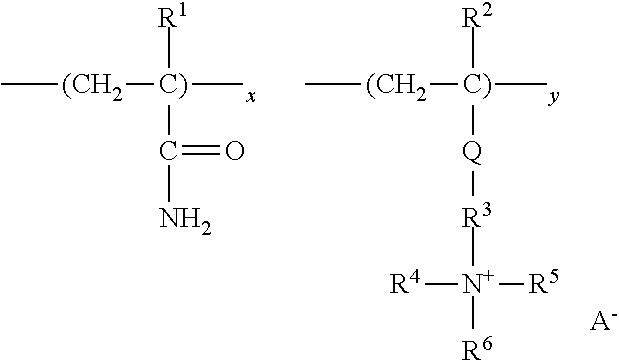Deoiling of SAGD produce water
- Summary
- Abstract
- Description
- Claims
- Application Information
AI Technical Summary
Benefits of technology
Problems solved by technology
Method used
Image
Examples
example 1
[0051]Several beakers with 200 ml of Location B SAGD produce water were obtained. The beakers were continuously stirred with paddle mixers. The initial pH of the produce water in the beakers was measured as 8. It was adjusted to a pH of 4 with sulfuric acid. Varying amounts of tannin based polymeric coagulant C#1 were added in the dosage range from 0 to 200 parts per million by volume. The coagulant was mixed for 60 seconds in all beakers. The pH of the produce water in the beakers was then adjusted to 8.5 with sodium hydroxide. After an additional 30 seconds of mixing, the cationic flocculant CF#1 was added to all the beakers at a dosage of 10 parts per million by volume. The cationic flocculant was mixed for an additional 15 seconds and then the anionic flocculant AF#1 was added at a dosage of 5 parts per million by volume. The stirring for the produce water was stopped after 2 minutes of total mixing time and the water was allowed to settle. For untreated produce water the turbid...
example 2
[0052]Several beakers with 200 ml of Location B SAGD produce water were obtained. The beakers were continuously stirred with paddle mixers. The initial pH of the produce water in the beakers was measured as 8. It was adjusted to a pH of 4 with sulfuric acid. Varying amounts of tannin based polymeric coagulant C#2 were added in the dosage range from 0 to 200 parts per million by volume. The coagulant was mixed for 60 seconds in all beakers. The pH of the produce water in the beakers was then adjusted to 8.5 with sodium hydroxide. After an additional 30 seconds of mixing, the cationic flocculant CF#1 was added to all the beakers at a dosage of 10 parts per million by volume. The cationic flocculant was mixed for an additional 15 seconds and then the anionic flocculant AF#1 was added at a dosage of 5 parts per million by volume. The stirring for the produce water was stopped after 2 minutes of total mixing time and the water was allowed to settle. For untreated produce water the turbid...
example 3
[0053]Several beakers with 200 ml of Location B SAGD produce water were obtained. The beakers were continuously stirred with paddle mixers. The initial pH of the produce water in the beakers was measured as 8. It was adjusted to a pH of 4 with sulfuric acid. Varying amounts of tannin based polymeric coagulant C#3 were added in the dosage range from 0 to 100 parts per million by volume. The coagulant was mixed for 60 seconds in all beakers. The pH of the produce water in the beakers was then adjusted to 8.5 with sodium hydroxide. After an additional 30 seconds of mixing, the cationic flocculant CF#1 was added to all the beakers at a dosage of 10 parts per million by volume. The cationic flocculant was mixed for an additional 15 seconds and then the anionic flocculant AF#1 was added at a dosage of 5 parts per million by volume. The stirring for the produce water was stopped after 2 minutes of total mixing time and the water was allowed to settle. For untreated produce water the turbid...
PUM
| Property | Measurement | Unit |
|---|---|---|
| Fraction | aaaaa | aaaaa |
| Fraction | aaaaa | aaaaa |
| Fraction | aaaaa | aaaaa |
Abstract
Description
Claims
Application Information
 Login to View More
Login to View More - R&D
- Intellectual Property
- Life Sciences
- Materials
- Tech Scout
- Unparalleled Data Quality
- Higher Quality Content
- 60% Fewer Hallucinations
Browse by: Latest US Patents, China's latest patents, Technical Efficacy Thesaurus, Application Domain, Technology Topic, Popular Technical Reports.
© 2025 PatSnap. All rights reserved.Legal|Privacy policy|Modern Slavery Act Transparency Statement|Sitemap|About US| Contact US: help@patsnap.com

